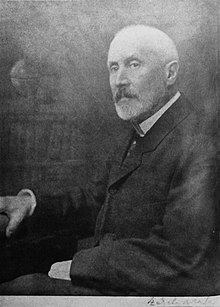Loránd Eötvös
Loránd Ágoston Eötvös [ ˈloraːnd aːgoʃtonˈøtvøʃ ] (born July 27, 1848 in Buda , † April 8, 1919 in Budapest ) was a Hungarian physicist and geophysicist . He was known internationally as ( Baron ) Roland von Eötvös (or Roland Eötvös ).
His most important research concerns capillary physics, gravity and the earth's magnetic field . In 1950 the Budapest Eötvös Loránd University was named after him.
Life and research
Loránd Eötvös, son of the writer and statesman József Eötvös , initially studied law in Budapest, but soon switched to physics and studied abroad in Heidelberg - with Kirchhoff , Helmholtz and Bunsen - and in Königsberg . After his habilitation in 1871, he became professor of physics at today's Loránd Eötvös University in Budapest , which has been named after him since 1950 ( Eötvös Loránd Tudományegyetem ).
Around 1906 he constructed a special rotary balance (which had previously been developed by John Michell , Charles-Augustin de Coulomb and Henry Cavendish ) to measure small spatial changes in gravity. These gravity gradients were then used for geophysical exploration of raw materials.
Thorough experiments enabled him to precisely demonstrate the principle of equivalence . According to this important principle of physics, the gravitational force depends only on the mass of the objects, but not on their material. a. means that when free falling in a vacuum, all bodies fall at the same speed. In general, experiments that check the equality of heavy and inert mass are called Eötvös experiments .
When he briefly Hungarian Education, Cultural Affairs and in 1894 Minister of Education was reformed Loránd Eötvös secondary schools in his country. He founded the Joseph Eötvös College to train good teachers and gave mathematics teaching an important role. This continues to have an impact on the European Thinking Sports and Mathematics Olympiads , whose competitions are often won by Hungarian high school students .
In 1883 he was elected to the Hungarian Academy of Sciences , of which he was president from 1889 to 1905. Since 1910 he was a corresponding member of the Prussian Academy of Sciences .
In addition to his scientific work, Eötvös was a well-known alpinist who made several first ascents in the Dolomites (mostly together with the mountain guide Michel Innerkofler ), e.g. B. Sesto Rotwand 1878. His daughters Ilona and Rolanda von Eötvös were also known as mountaineers in the Dolomites. For many years he was the President of the Hungarian Tourism Association.
Anecdotes
Valentine Telegdi tells the following anecdote about Eötvös, who as (former) Minister of Education was entitled to the title of “Excellence”. Eötvös was a medical student. When he inadvertently addressed him as professor during the test, Eötvös said: Well, my young friend, when we have reached this point, you can call me Uncle Roland right away . Telegdi, who was himself a Hungarian, also emphasizes that it was absolutely unusual for the Hungarian landed nobility to go into research or teaching.
Are also named after him
- the Eötvös rule
- the meanwhile inadmissible unit Eötvös for specifying changes in gravity between different geographical measuring points in geophysics.
- in the field of fluid mechanics the Eötvös number , which is used as a dimensionless number to determine the shape of a fluid sphere (air bubble, etc.)
- the Eötvös effect , the vertical deflection caused by the Coriolis force
- the Eötvös crater on the moon
- the asteroid (12301) Eötvös
- the mountain peak Cima Eötvös of the Cadini group in the Dolomites
- the mineral lorandite
literature
- Eötvös Roland Baron. In: Austrian Biographical Lexicon 1815–1950 (ÖBL). Volume 1, Verlag der Österreichischen Akademie der Wissenschaften, Vienna 1957, p. 257.
- Lászlo Kovács: Eötvös Loránd, tudós-tanár . UP, Szombathely 2002, ISBN 963-9290-25-4
Web links
- Literature by and about Loránd Eötvös in the catalog of the German National Library
- Eötvös Loránd Virtual Museum (English)
- Gabriele Dörflinger: Eötvös, Loránd (July 27, 1848 - April 8, 1919) (PDF, 3 MB, created 2016) in the Homo Heidelbergensis mathematicus collection of the Heidelberg University Library
Individual evidence
- ↑ He enrolled as Roland Eötvös in Heidelberg, cf. Portrait of the University of Heidelberg , and published in German under the name Roland von Eötvös , cf. Correspondence with Einstein: Table of Contents for Einstein, A .; Hentschel, A., trans .: The Collected Papers of Albert Einstein, Volume 8: The Berlin Years: Correspondence, 1914-1918. (English supplement translation) ( Memento of the original dated June 11, 2007 in the Internet Archive ) Info: The archive link was inserted automatically and has not yet been checked. Please check the original and archive link according to the instructions and then remove this notice. . This name is still often used today, cf. www.time.com: A Fifth Force? dated June 21, 2005.
- ^ Members of the previous academies. Loránd (Roland) Baron Eötvös. Berlin-Brandenburg Academy of Sciences and Humanities , accessed on March 19, 2015 .
- ↑ Most important climbings of Loránd Eötvös
- ↑ (Climbings of) the whole family
- ↑ (Climbings of) Ilona and Rolanda Eötvös
- ^ The life of Loránd Eötvös
- ^ Telegdi, Oral History Project, Caltech
- ↑ esa: Basic Measurement Units
| personal data | |
|---|---|
| SURNAME | Eötvös, Loránd |
| ALTERNATIVE NAMES | Eötvös, Loránd Ágoston (full name) |
| BRIEF DESCRIPTION | Hungarian physicist and geophysicist |
| DATE OF BIRTH | July 27, 1848 |
| PLACE OF BIRTH | Buda |
| DATE OF DEATH | April 8, 1919 |
| Place of death | Budapest |
